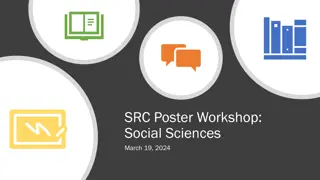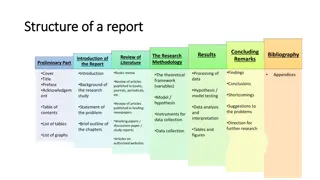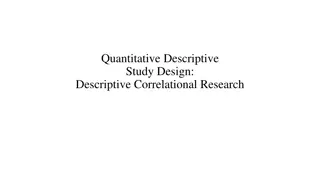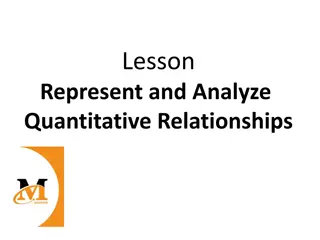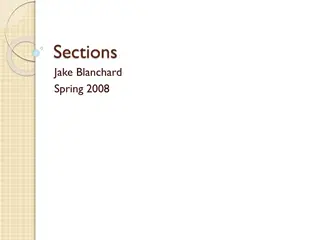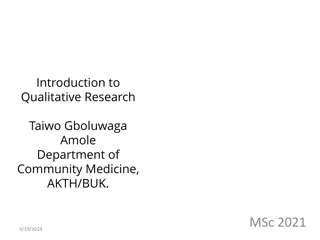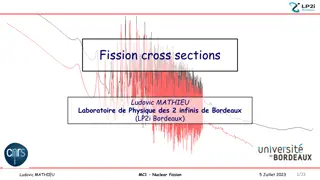Writing Tips for Quantitative Methodology and Results Sections
Learn how to craft a clear and detailed methods section, identify participants effectively, address measures accurately, choose the right research design, and follow proper procedures in your quantitative research study.
Download Presentation

Please find below an Image/Link to download the presentation.
The content on the website is provided AS IS for your information and personal use only. It may not be sold, licensed, or shared on other websites without obtaining consent from the author.If you encounter any issues during the download, it is possible that the publisher has removed the file from their server.
You are allowed to download the files provided on this website for personal or commercial use, subject to the condition that they are used lawfully. All files are the property of their respective owners.
The content on the website is provided AS IS for your information and personal use only. It may not be sold, licensed, or shared on other websites without obtaining consent from the author.
E N D
Presentation Transcript
Writing Quantitative Methodology and Results Sections James Ikonomopoulos Ph.D., LPC-S
Method The methods section should be clear and detailed enough to provide information to critique the validity of the study and to replicate it. The methods section walks through each step of the research study. The four main areas in the methods section are participants, instruments, research design, and procedures. Sheperis, C. J. & Young, J. S. (2017). Counseling Research: Quantitative, Qualitative, and Mixed Methods 2nd edition. Upper Saddle river, NJ: Pearson Prentice-Hall American Psychological Association (2020). Publication manual of the American Psychological Association (7th ed.). Washington DC: Author.
Participants This section should answer the following questions: Who are the participants of this study? How were they selected? How many participants make up the sample? Are there different groups of participants (an experimental and control group, or other types of groups being compared) How many participants are in each group? What are the demographics of the sample, such as age, gender, ethnicity, region of residence, or other relevant characteristics? Sheperis, C. J. & Young, J. S. (2017). Counseling Research: Quantitative, Qualitative, and Mixed Methods 2nd edition. Upper Saddle river, NJ: Pearson Prentice-Hall American Psychological Association (2020). Publication manual of the American Psychological Association (7th ed.). Washington DC: Author.
Measures Address each construct or variable and describe the instrument used to measure it. The instrument description should include, the full name of the instrument, authors, appropriate citations, previous evidence of reliability and validity, information about the sample on which it was normed, number and type of items (e.g., Likert scale). Sheperis, C. J. & Young, J. S. (2017). Counseling Research: Quantitative, Qualitative, and Mixed Methods 2nd edition. Upper Saddle river, NJ: Pearson Prentice-Hall American Psychological Association (2020). Publication manual of the American Psychological Association (7th ed.). Washington DC: Author.
Research Design Identify the research design that is being used. Indicate how the variables are organized in the study in order to answer the research questions. Is the design correlational, ex-post facto, causal-comparative, experimental, or quasi- experimental in nature? Sheperis, C. J. & Young, J. S. (2017). Counseling Research: Quantitative, Qualitative, and Mixed Methods 2nd edition. Upper Saddle river, NJ: Pearson Prentice-Hall American Psychological Association (2020). Publication manual of the American Psychological Association (7th ed.). Washington DC: Author.
Procedures Provides the reader with a detailed, step-by-step guide to how the study was conducted. Describes precisely what was done, and when, where, and how each step was completed. Includes how the participants were contacted, how informed consent and parental permission was addressed, how the instruments were administered and in what order, instructions that were given to the participants, how experimental conditions were manipulated. Sheperis, C. J. & Young, J. S. (2017). Counseling Research: Quantitative, Qualitative, and Mixed Methods 2nd edition. Upper Saddle river, NJ: Pearson Prentice-Hall American Psychological Association (2020). Publication manual of the American Psychological Association (7th ed.). Washington DC: Author.
Method (JARS standards) Inclusion and Exclusion Report inclusion and exclusion criteria including and restrictions based on demographic characteristics. Participant Characteristics Report major demographic characteristics (e.g., age, sex, ethnicity, socioeconomic status) and important topic specific characteristics (e.g. achievement level) American Psychological Association (2020). Publication manual of the American Psychological Association (7th ed.). Washington DC: Author.
Method Participant Characteristics continued In the case of animal research, report the genus, species, and strain number or other specific identification, such as the name and location of the stock designation. Give the number of animals, and the animal s sex, age, weight, physiological condition, genetic modification status, genotype, health immune status, and previous procedures to which the animal may have been subjected. American Psychological Association (2020). Publication manual of the American Psychological Association (7th ed.). Washington DC: Author.
Method continued Sampling Procedures Describe procedures for selecting participants including Sampling method if a systematic sampling plan was implemented Percentage of the sample approached that actually participated Whether self selection into the study occurred (either by individual or by units, such as schools or clinics) Describe settings and locations where data were collected as well as dates of data collection. American Psychological Association (2020). Publication manual of the American Psychological Association (7th ed.). Washington DC: Author.
Method continued Sampling Procedures Describe agreements and payments made to participants Describe institutional review board agreements, ethical standards met, and safety monitoring Sample Size, Power, and Precision Describe the sample size, power, and precision including intended sample size, achieved sample size, and determination of sample size including power analysis, or methods used to determine precision of parameter estimates Explanation of any interim analyses and stopping rules employed American Psychological Association (2020). Publication manual of the American Psychological Association (7th ed.). Washington DC: Author.
Method continued Measures and Covariates Define all primary and secondary measures and covariates, including measures collected but not included in the report Data Collection Describe methods used to collect data Quality of Measurements Describe methods used to enhance the quality of measurements including Training and reliability of data collectors Use of multiple observations American Psychological Association (2020). Publication manual of the American Psychological Association (7th ed.). Washington DC: Author.
Method continued Instrumentation Provide information on validated or ad-hoc instruments created for individual studies (psychometric and biometric properties) Masking Report whether participants, those administering the experimental manipulations, and those assessing the outcomes were aware of condition assignments American Psychological Association (2020). Publication manual of the American Psychological Association (7th ed.). Washington DC: Author.
Method continued Psychometrics Estimate and report reliability coefficients for the scores analyzed (i.e., the researchers sample), if possible. Provide evidence of convergent and discriminant validity where relevant. Report estimates related to the reliability of measures including Interrater reliability for subjectively scored measures and ratings Test-retest coefficients in longitudinal studies in which the retest interval corresponds to the measurement schedule used in the study Internal consistency coefficients for composite scales Report the basic demographic characteristics of other samples if reporting reliability and validity coefficients from those samples such as those described in test manuals or norming American Psychological Association (2020). Publication manual of the American Psychological Association (7th ed.). Washington DC: Author.
Method continued Conditions and Design State whether conditions were manipulated or naturally observed. Report the type of design experimental manipulation with participants randomized experimental manipulation without randomization clinical trial with randomization clinical trial without randomization nonexperimental design (i.e., no experimental manipulation): observational design, epidemiological design, natural history, and so forth (single- group designs or multiple group comparisons) longitudinal design N-of-1 studies replications American Psychological Association (2020). Publication manual of the American Psychological Association (7th ed.). Washington DC: Author.
Method continued Data Diagnostics Describe planned data diagnostics, including Criteria for post-data-collection exclusion of participants, if any criteria for deciding when to infer missing data and methods used for imputation of missing data definition and processing of statistical outliers analyses of data distributions data transformations to be used, if any American Psychological Association (2020). Publication manual of the American Psychological Association (7th ed.). Washington DC: Author.
Method continued Analytic Strategy Describe the analytic strategy for inferential statistics and protection against experiment wise error for primary hypotheses secondary hypotheses exploratory hypotheses American Psychological Association (2020). Publication manual of the American Psychological Association (7th ed.). Washington DC: Author.
Results This is the section in which the actual findings of the study are presented. What statistical tests were run and the results of these analyses are presented. A summary of the statistical results, along with the statistical significance, effect size, and power should be provided. Connect the findings with the stated research questions and illuminate if findings support or refute your hypotheses. American Psychological Association (2020). Publication manual of the American Psychological Association (7th ed.). Washington DC: Author.
Results (JARS standards) Participant Flow Report the flow of participants, including total number of participants in each group at each stage of the study flow of participants through each stage of the study (include figure depicting flow, when possible; see the JARS Quant Participant Flowchart) Recruitment Provide dates defining the periods of recruitment and repeated measures or follow-up. American Psychological Association (2020). Publication manual of the American Psychological Association (7th ed.). Washington DC: Author.
Results Statistical and Data Analysis Provide information detailing the statistical and data- analytic methods used, including complex data analyses for example, structural equation modeling analyses (see also Table 7), hierarchical linear models, factor analysis, multivariate analyses, and so forth, including details of the models estimated associated variance covariance (or correlation) matrix or matrices identification of the statistical software used to run the analyses (e.g., SAS PROC GLM or the particular R package) estimation problems (e.g., failure to converge, bad solution spaces), regression diagnostics, or analytic anomalies that were detected and solutions to those problems. other data analyses performed, including adjusted analyses, if performed, indicating those that were planned and those that were not planned (though not necessarily in the level of detail of primary analyses). Report any problems with statistical assumptions and/or data distributions that could affect the validity of findings.
Reference American Psychological Association (2020). Publication manual of the American Psychological Association (7thed.). Washington DC: Author. Sheperis, C. J. & Young, J. S. (2017). Counseling Research: Quantitative, Qualitative, and Mixed Methods 2nd edition. Upper Saddle river, NJ: Pearson Prentice-Hall



